The Critical Role of Body Bags in Modern Mortuary Operations
A body bag body containment system is a non-porous pouch designed to safely transport and store human remains while maintaining dignity and preventing contamination. These specialized containers are essential tools for funeral directors, medical examiners, and emergency response teams.
| Key Purpose of Body Bags | Description |
|---|---|
| Containment | Prevents leakage of bodily fluids and limits exposure to pathogens |
| Preservation | Helps maintain the condition of remains during transport and storage |
| Dignity | Provides respectful coverage and handling of the deceased |
| Safety | Protects handlers from biological hazards and cross-contamination |
| Evidence Protection | Maintains chain of custody for forensic investigations |
Body bags come in various materials, sizes, and specifications to address different needs. Standard adult bags typically measure 36" × 90" with weight capacities ranging from 400 lbs for regular use to 3,500 lbs for bariatric options. Modern designs feature reinforced handles, leak-resistant seals, and specialized materials for various applications.
Whether you're handling routine removals or preparing for mass-casualty incidents, selecting the right body bag is crucial for operational efficiency and safety compliance.
The evolution of body bag technology has progressed significantly from simple vinyl pouches to sophisticated containment systems with heat-sealed barriers, viewing windows, and environmentally friendly materials.
I'm Mortuary Cooler, with over 25 years of experience in the mortuary equipment industry, specializing in body bag body containment solutions for funeral homes across America. My work with both standard and specialized body bags has given me unique insights into the practical challenges funeral directors face when selecting appropriate containment options.
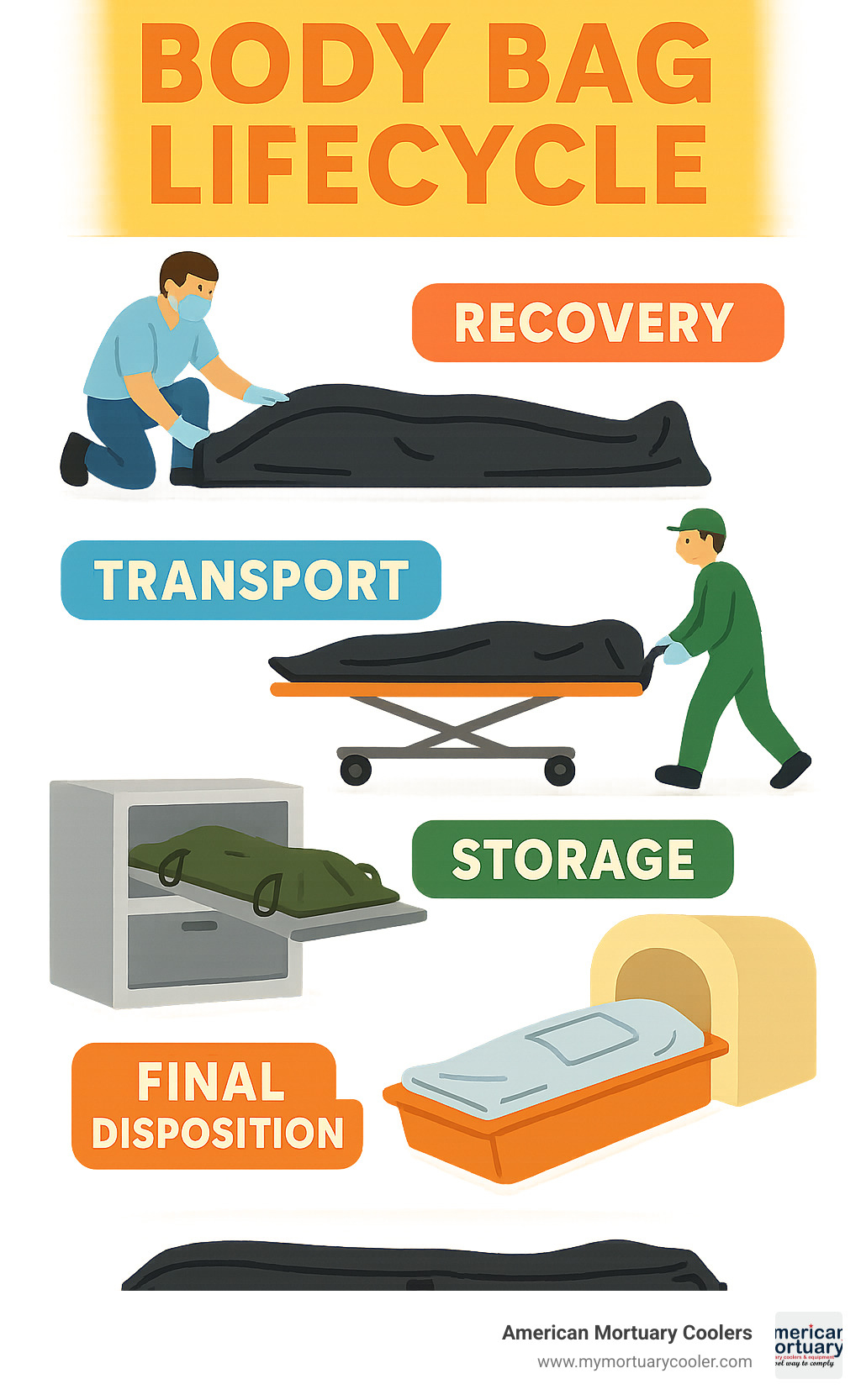
Understanding the Body Bag Body: Definition & Purpose
A body bag, also known as a cadaver pouch or human remains pouch (HRP), is the frontline solution for containing deceased individuals from recovery through final disposition. These specialized pouches balance practical needs with dignity for the deceased, serving as the unsung heroes of mortuary care.
Here at American Mortuary Coolers, we've witnessed how quality body bag body containment systems contribute to respectful handling, safe transport, and proper storage across scenarios ranging from everyday funeral home operations to large-scale disaster response.

Body Bag Body: Primary Purposes
When it comes to protecting handlers and honoring the deceased, body bag body containment systems serve several critical functions.
Infection control stands as perhaps the most vital purpose, creating a reliable barrier that prevents potentially infectious agents from spreading to handlers and the surrounding environment. This protection becomes especially crucial in cases involving communicable diseases or decomposition.
Evidence preservation is another key function, particularly in forensic cases. A properly sealed body bag maintains the integrity of trace evidence, bodily fluids, and personal effects that might prove essential for investigation.
Some advanced designs like the BodySealer system offer refrigeration delay capabilities by effectively trapping gases and liquids, potentially reducing immediate cooling requirements in certain situations – a significant advantage when resources are limited.
Perhaps most importantly, these containment systems facilitate respectful handling, providing a dignified means of transporting remains while shielding the deceased from public view. This consideration brings comfort to families during an already difficult time.
As mortuary equipment specialists, we understand each purpose demands specific design features – from leak-resistant materials for infection control to specialized labeling systems for evidence tracking.
What Is a Body Bag and How Did It Evolve?
The journey of the modern body bag body containment system tells a fascinating story of innovation born from necessity. Dating back to the American Civil War, the first U.S. patent (No. 39,291) for a body bag-like device was filed on July 21, 1863, by Thomas Holmes, who recognized the urgent need for better containment during wartime casualties.
World War II saw military personnel improvising with cotton mattress covers and parachute canopies, as standardized body bags weren't yet available. By the Vietnam War, heavy black rubberized fabric bags became standard issue for American forces, marking a significant step forward in design and functionality.
The Falklands War highlighted the utility of plastic body bags in challenging field conditions, with British forces using them for mass casualties. As described in a Slate article on "transfer tubes", military terminology has evolved over time, sometimes using euphemisms like "transfer tubes" instead of "body bags."
Today's modern body bag body containment systems have come a long way from their historical roots, incorporating advanced materials, ergonomic designs, and specialized features that their predecessors could hardly imagine.
Body Bag Body vs. Alternative Post-Mortem Solutions
When considering options for handling the deceased, it's helpful to understand how body bag body systems compare to alternatives like coffins, caskets, and shrouds:
| Feature | Body Bags | Coffins/Caskets | Shrouds |
|---|---|---|---|
| Primary Use | Temporary containment & transport | Final disposition | Cultural/religious practices |
| Material | Non-porous plastic/vinyl | Wood, metal, or composite | Cloth or biodegradable material |
| Fluid Containment | Excellent | Variable (depends on lining) | Poor |
| Reusability | Single-use | Not intended for reuse | Single-use |
| Weight | Lightweight (2-5 lbs) | Heavy (100+ lbs) | Very lightweight |
| Cost | $30-$300 | $1,000-$10,000+ | $20-$200 |
| Storage Efficiency | High | Low | Medium |
Unlike coffins and caskets designed primarily for viewing and burial, body bag body containment systems excel at what they're engineered to do – safely transport and temporarily store remains. They offer superior fluid containment, easy portability, and efficient space utilization, which becomes critically important during mass casualty events or in settings with limited resources.
For disaster response, specialized options like the disaster pouch provide improved capabilities for challenging recovery situations. The practical differences between standard body bags and disaster pouches are significant enough that we've created a dedicated resource on Disaster Pouch vs Body Bags Explained.
At American Mortuary Coolers, we recommend facilities maintain an appropriate inventory of body bags alongside their refrigeration solutions. This combination ensures complete preparedness for whatever circumstances may arise – because in our line of work, being prepared isn't just good business; it's a matter of dignity and respect.
Comprehensive Guide to Body Bag Types & Categories
The world of body bag body containment has grown remarkably diverse over the years. Today, there's a specialized solution for virtually every situation a funeral director might encounter. Knowing these options helps ensure you're prepared for whatever comes through your doors.
Standard & Heavy-Duty Bags
Your everyday standard body bag typically features 8 mil PVC construction - sturdy enough for routine funeral home and hospital transfers. These workhorses generally support up to 400 pounds and come with 6 handles for safe transport. At 36" × 90", they accommodate most adult remains comfortably.
When you need something more robust, heavy-duty options step up with thicker 15 mil vinyl and reinforced construction. I've spoken with many funeral directors who prefer these for everyday use, especially in rural areas where transport might involve rough terrain or unpredictable weather.
"I switched to heavy-duty bags last year after a particularly difficult removal down a steep embankment," a director from eastern Tennessee told me. "The peace of mind is worth every penny."
Our Complete Guide to Heavy Duty Body Bags walks through all the options if you're considering an upgrade from standard pouches.
Bariatric & Oversize Solutions
The need for dignified care extends to every person, regardless of size. Modern bariatric body bag body solutions can support an impressive 3,500 pounds with dimensions of 54" × 108" - providing respectful accommodation for larger individuals.
These engineering marvels typically feature 16 reinforced strap handles positioned for optimal weight distribution during transport. The reinforced scrim material prevents tearing even under significant strain, while extra-thick material (often 22 mil or greater) ensures containment integrity. The zipper systems are specially designed to handle larger circumferences while maintaining a secure closure.
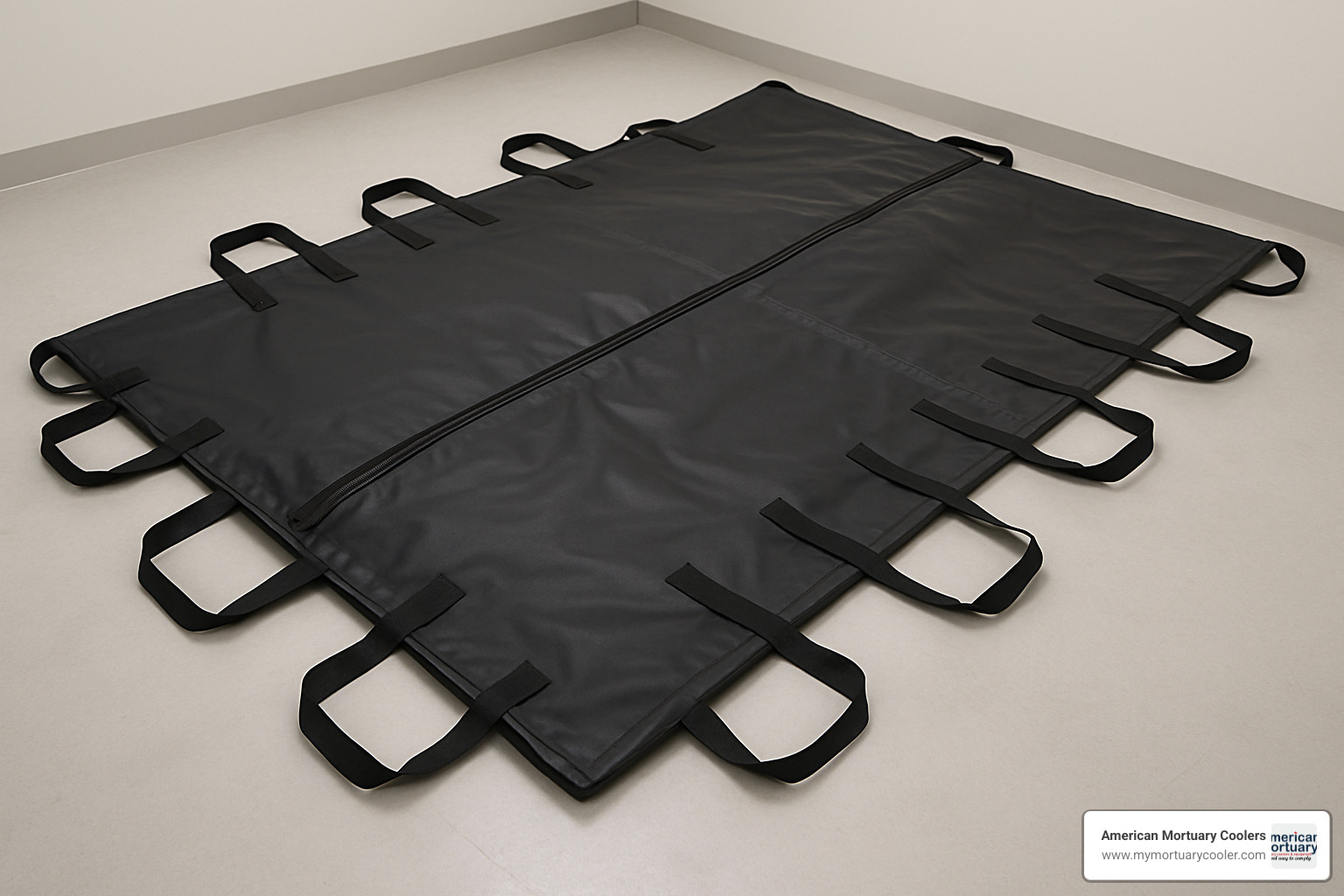
Specialized Bags for Unique Scenarios
Sometimes, standard solutions just won't cut it. That's when specialized body bag body containment systems come into play:
Water Recovery Mesh Bags are a game-changer for remains recovered from aquatic environments. The mesh material allows water to drain while securely containing remains, and most include drainage grommets to speed the process. These typically support up to 450 pounds and make a difficult situation slightly more manageable.
When dealing with highly infectious remains, BSL-4 Heat-Sealed Bags like the BioSeal and BodySealer systems provide hermetic sealing that can withstand up to 4,000 PSI. These meet the stringent Biosafety Level 4 requirements - the highest level of biological containment.
For cremation-bound remains, Chlorine-Free Cremation Bags made from PEVA (Polyethylene Vinyl Acetate) eliminate chlorinated materials that could produce harmful emissions during the cremation process.
The growing popularity of alkaline hydrolysis has created demand for PVA Water-Soluble Bags that dissolve during the "water cremation" procedure, simplifying the process for funeral homes offering this green alternative.
Military DOD Spec Bags meet strict Department of Defense specifications with improved durability, standardized dimensions, and specific labeling requirements. While primarily used by military facilities, some civilian operations prefer these for their consistency and quality.
The COVID-19 pandemic brought new challenges that prompted the development of Pandemic Response Bags with improved sealing features and thicker materials to better protect handlers from potential exposure.
At American Mortuary Coolers, we've built relationships with suppliers of all these specialized options because we understand that being prepared means having access to the right tool for each unique situation. Whether you're serving families in metropolitan Chicago or rural Georgia, we can help ensure you have exactly what you need when it matters most.
Construction, Sizes, and Key Features That Matter
When it comes to body bag body containment systems, the details really do matter. The materials, dimensions, and special features all work together to create a product that's not just functional, but actually helps funeral professionals do their jobs better and with greater safety.
Material Choices & Advantages
The material of a body bag body is perhaps its most critical component. Over my years working with funeral homes across America, I've seen how different materials perform in real-world situations:
PVC (Polyvinyl Chloride) remains the most popular choice, and for good reason. It offers excellent durability and resistance to fluids – crucial qualities when handling remains. Standard PVC bags typically range from 6-8 mil thickness, while heavy-duty versions can reach a substantial 15-22 mil for challenging situations.
PEVA (Polyethylene Vinyl Acetate) has become increasingly popular as a chlorine-free alternative. Not only does it produce fewer harmful emissions during cremation (an important consideration for environmentally-conscious facilities), but it also maintains flexibility in extremely cold conditions – down to a remarkable –70°F. This makes PEVA bags ideal for facilities in colder regions or those with limited refrigeration capacity.
For situations requiring extra strength, nylon-reinforced scrim provides superior tear resistance by incorporating a woven nylon mesh within the plastic material. I've had many clients tell me how grateful they were for this reinforcement when handling bariatric cases or working in challenging removal environments.
Some advanced systems like BodySealer incorporate a metal-foil barrier layer that not only improves containment but allows for x-ray examination without opening the bag – a feature that can be invaluable in forensic situations.
Scientific research on polymer barriers consistently shows that multi-layer constructions significantly outperform single-layer materials in preventing fluid leakage and maintaining integrity under stress. This isn't just theoretical – it's a critical real-world consideration when selecting bags for infectious disease cases.
Standardized Dimensions & Capacities
Body bag body containment systems come in standardized sizes to accommodate various needs:
Adult Standard: 36" × 90" (91 × 229 cm), supporting up to 400 lbs
Child/Adolescent: 31" × 49" (79 × 124 cm)
Bariatric Standard: 40" × 96" (102 × 244 cm), supporting up to 1,000 lbs
Jumbo Bariatric: 54" × 108" (137 × 274 cm), supporting up to 3,500 lbs
Infant/Premie: Specialized smaller dimensions for the youngest decedents
At American Mortuary Coolers, we've found that facilities serve their communities best when they maintain an inventory that reflects their demographic service area. Our metropolitan clients typically need a broader range of sizes than those in rural areas, though we always recommend having at least some variety on hand for unexpected situations.
Modern Add-Ons Elevating Body Bag Body Designs
The body bag body has come a long way from simple plastic pouches. Today's advanced containment systems incorporate numerous features that significantly improve functionality:
Heat-seal tapes and systems represent one of the biggest innovations in recent years. These allow for hermetic sealing without zippers, creating an airtight environment that may reduce or eliminate immediate refrigeration needs in some cases. This technology has been particularly valuable during mass casualty events when refrigeration resources are stretched thin.
Transparent BioVu windows enable visual identification without opening the bag. I've had funeral directors tell me how much they appreciate this feature when handling infectious cases, as it reduces exposure risk while still allowing for proper identification and documentation.
Reinforced strap handles distribute weight more effectively than traditional cut-out handles. This seemingly small feature can make a tremendous difference in preventing staff injuries during transport – something every funeral home owner worries about.
Color coding serves important practical purposes. White bags improve evidence visibility for forensic cases, while black or orange may be used for specific protocols or disaster response. This simple visual system can help maintain order during chaotic situations.
The emerging technology of RFID tagging facilitates tracking throughout the chain of custody, which is particularly valuable for medical examiners and in mass casualty situations.
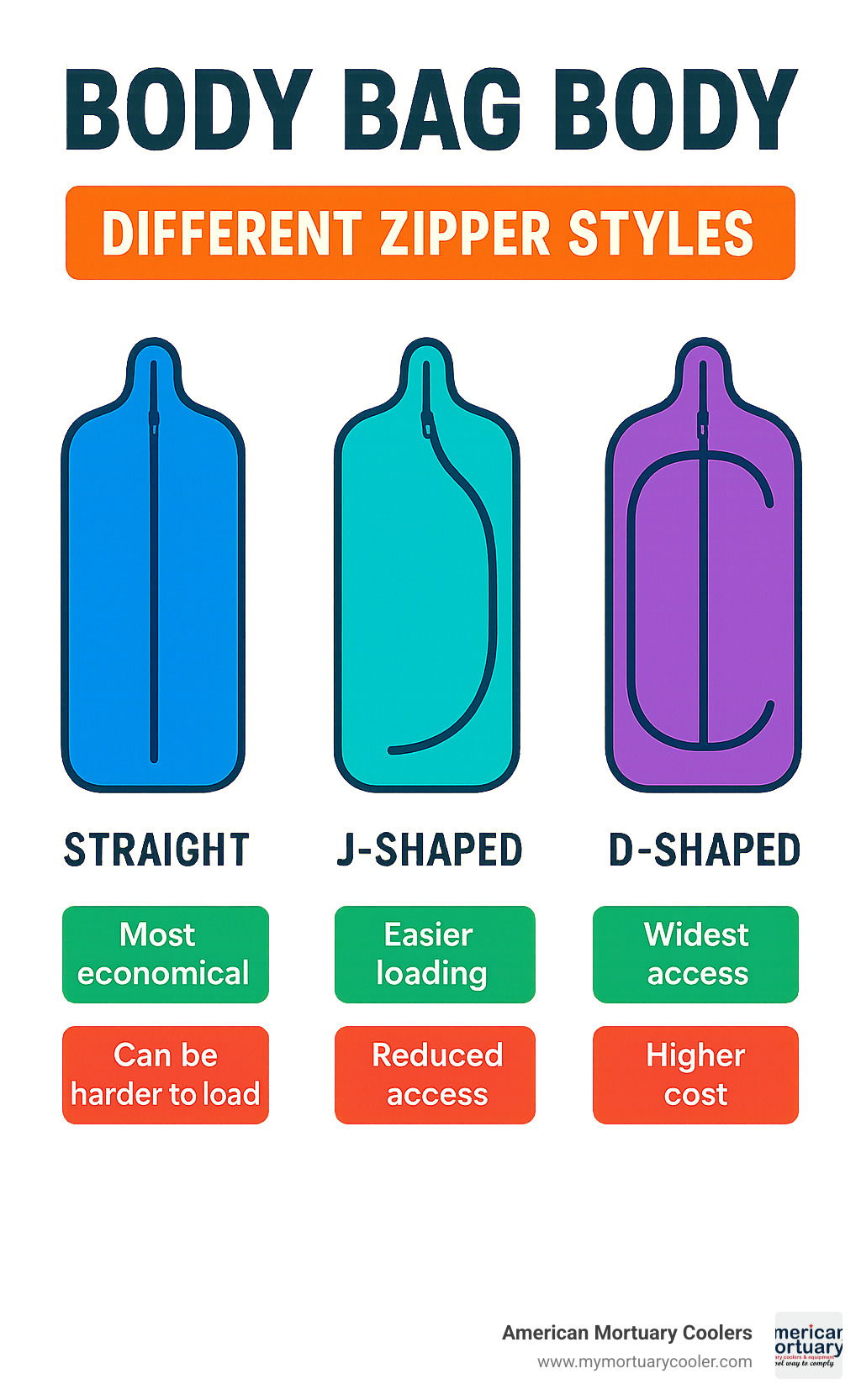
Zipper design might seem like a minor detail, but it can make a major difference in daily operations. Straight zippers offer the most economical option and work well for routine cases. C-curve zippers follow the natural contour of the body, making loading significantly easier – a feature appreciated by those who handle multiple cases daily. Envelope-style openings provide the widest access for placing remains in the bag, which can be particularly helpful in challenging recovery situations.
In my years of working with funeral homes across the country, I've noticed that facilities handling higher volumes typically prefer C-curve zippers and reinforced handles. The initial investment in these higher-quality features quickly pays off through improved efficiency and durability – not to mention reduced physical strain on staff members.
Protocols, Best Practices, and Compliance Standards
Working with body bag body containment systems isn't just about having the right equipment—it's about knowing how to use it properly. Over my years at American Mortuary Coolers, I've seen how following established protocols not only ensures safety but also preserves the dignity of those who have passed.
Preparing, Using, and Disposing of Body Bags Safely
When it comes to handling body bags, safety starts before you even touch the deceased. First, always protect yourself by donning appropriate PPE—gloves, gown, and face protection are your basic necessities. Many funeral professionals I've worked with have developed their own routines, but the fundamentals remain consistent.
Before placing remains in the bag, consider laying down an absorbent pad if you anticipate any fluid leakage. This simple step can make a world of difference during transport. Unfold the bag completely beside the deceased, ensuring you have enough space to work comfortably.
When transferring the deceased, proper lifting techniques aren't just about preventing back injuries—they show respect for the departed. For cases involving infectious diseases, double-bagging provides an extra layer of protection that many of our clients find reassuring. The inner bag contains the remains while the outer bag remains clean for handlers.
Properly sealing the bag is crucial. Make sure the zipper closes completely without catching on clothing or other items. If you're using a heat-sealed system like BioSeal, following the manufacturer's temperature guidelines ensures a proper seal. I always recommend doing a quick integrity check by gently pressing on the sealed bag to check for escaping air—it's a simple test that can prevent problems down the road.
After use, most body bags are incinerated with other biohazardous materials. For those using alkaline hydrolysis (often called "water cremation"), specialized water-soluble bags are available that dissolve during the process, something more of our clients are asking about as this technology becomes more widespread.
For a deeper dive into evaluating high-containment options, check out our Step-by-Step Guide to Evaluating BioSeal Body Bags, which walks through testing procedures for facilities handling infectious remains.
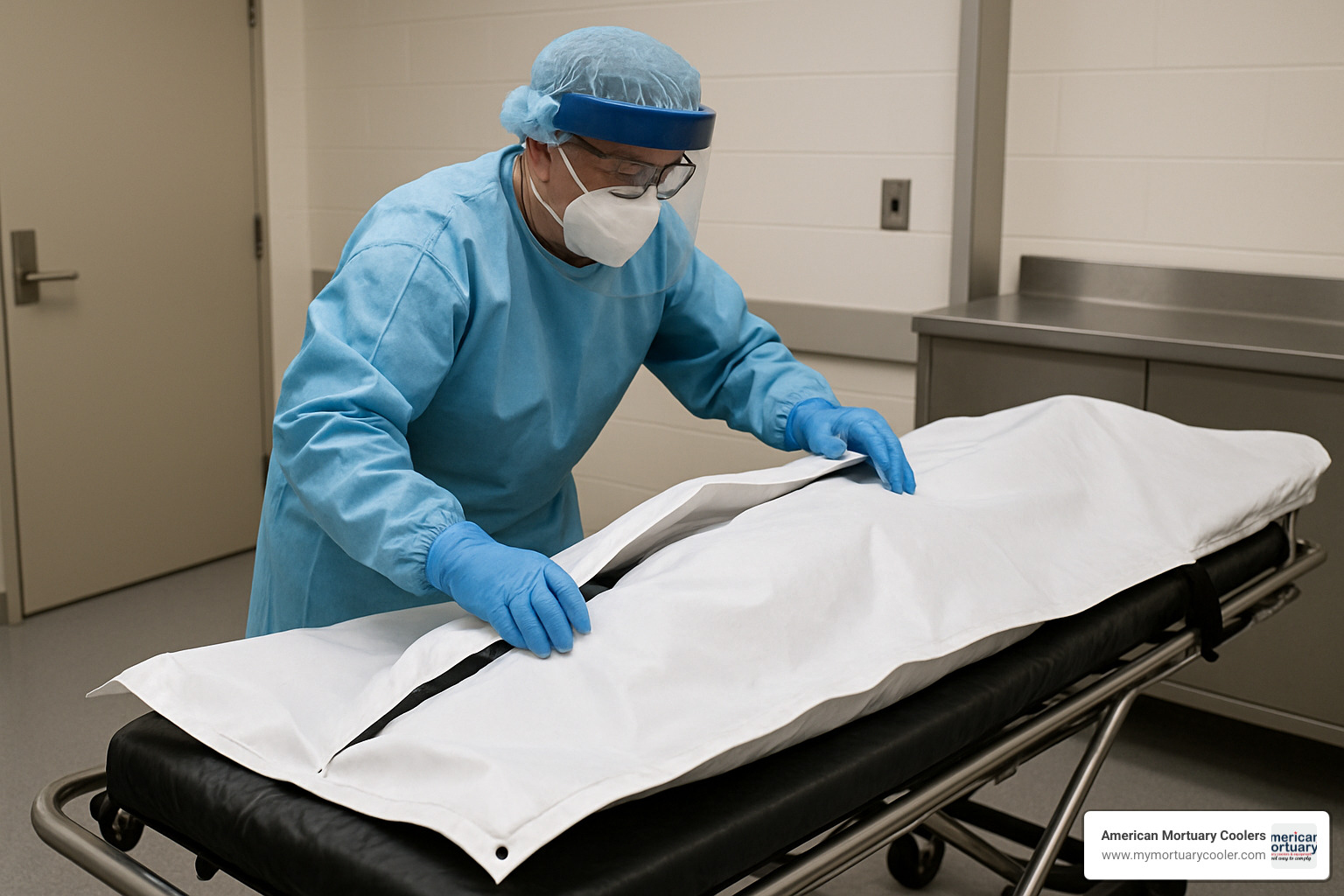
Field Protocols for Disaster & Military Operations
When disaster strikes, standard procedures often need adaptation. In mass-casualty events, triage tagging systems become essential for linking the deceased with identifying information and recovery location. I've worked with emergency management teams who praise these systems for maintaining order during chaotic situations.
Refrigeration alternatives have become game-changers in field operations. Products like the BodySealer create hermetically sealed environments that can potentially reduce immediate cooling requirements—a critical advantage when resources are stretched thin. This technology has been particularly valuable for our rural clients who sometimes face longer transport times.
FEMA's standardized disaster response kits include specific types and quantities of body bags based on incident scale. Having helped stock these kits for several regional emergency management agencies, I can tell you the peace of mind they provide is immeasurable.
When refrigeration is limited, cooling adjuncts like Mopec MERC cooling pads can supplement body bags effectively. During one summer power outage, a funeral home director told me these pads saved the day until their generator could be repaired.
At American Mortuary Coolers, we regularly work with emergency management agencies throughout Tennessee, Georgia, Illinois, and beyond to ensure they're prepared for the unthinkable, providing both refrigeration solutions and appropriate containment systems custom to their specific needs.
Regulatory Check-List Before Procurement
Navigating regulations might not be the most exciting part of funeral service, but it's certainly one of the most important. When selecting body bag body containment systems, several standards must be considered:
OSHA 29 CFR 1910.1030 establishes requirements for handling potentially infectious materials. This regulation isn't just a suggestion—it's a legal requirement that protects you and your staff.
CDC Guidelines provide specific recommendations for handling remains with infectious diseases. During the COVID-19 pandemic, these guidelines evolved rapidly, and we worked closely with our clients to ensure they had the appropriate containment options.
EPA Regulations restrict the incineration of chlorinated materials, which affects disposal options for traditional PVC bags. This is why more of our clients are exploring PEVA alternatives, especially those who work closely with crematories.
DOD HRP Specifications set the standards for military-grade human remains pouches. These exacting requirements ensure consistent quality and performance in challenging conditions.
I always recommend that our clients maintain documentation of compliance with these standards. It's not just about checking boxes—it's about demonstrating your commitment to professional excellence. Our team at American Mortuary Coolers can help ensure your body bag inventory meets all applicable requirements, giving you one less thing to worry about in your already demanding profession.
Green Innovations & Historical Trends
The world of body bag body containment has come a long way, with recent years showing a strong shift toward environmental responsibility and cutting-edge technology. These changes reflect our industry's commitment to sustainability without sacrificing the quality and functionality that funeral professionals depend on.
Eco-Friendly Body Bag Body Options
The funeral industry is increasingly embracing greener alternatives that align with modern environmental values:
PEVA cremation-safe materials have become a popular alternative to traditional PVC. These chlorine-free options produce significantly fewer harmful emissions during the cremation process, helping funeral homes meet EPA air quality standards while providing the same reliable containment.
When I visit funeral homes across Tennessee and beyond, I'm seeing more directors choosing PVA alkaline hydrolysis compatible bags. These water-soluble polyvinyl alcohol products completely dissolve during the "water cremation" process, leaving no plastic residue behind – a perfect match for this increasingly popular disposition method.
Some forward-thinking manufacturers are now experimenting with biodegradable starch blends that break down more readily in landfill environments. While these materials are still gaining traction in the primary containment market, they represent an important step toward reducing the environmental footprint of mortuary operations.
Perhaps most innovative are the refrigeration-free options like the BodySealer system. By creating hermetically sealed environments, these products may reduce or even eliminate immediate refrigeration needs in certain circumstances – potentially saving significant energy while maintaining proper containment.
Our team at American Mortuary Coolers has noticed growing interest in these sustainable options, particularly from urban funeral homes where cremation rates tend to be highest. For more detailed comparisons between traditional and eco-friendly containment systems, especially in emergency scenarios, check out our Disaster Pouch vs Body Bags Explained resource.
Milestones That Shaped Today's Body Bags
The body bag body containment systems we use today didn't appear overnight – they evolved through several key historical developments:
During the Cold War stockpiling era, government preparations for potential mass casualties led to standardized specifications and large-scale production capabilities. This period was even referenced in Adrian Mitchell's protest poem "Fifteen Million Plastic Bags," highlighting how these practical items had entered the cultural consciousness.
The 9/11 response efforts presented unprecedented challenges that drove significant innovations. The World Trade Center recovery operation required advanced systems for identification, tracking, and specialized containment for fragmented remains – improvements that continue to benefit forensic operations today.
More recently, the COVID-19 pandemic created extraordinary demand for body bags, forcing manufacturers to ramp up production while developing improved containment features. This global health crisis highlighted the need for high-containment options even in routine healthcare settings, permanently changing industry standards.
Heat-sealing technology represents one of the most significant technical advances in recent years. Modern polymer welding techniques have enabled the development of hermetically sealed containment systems that provide superior protection compared to traditional zippered designs – a genuine leap forward in both safety and functionality.
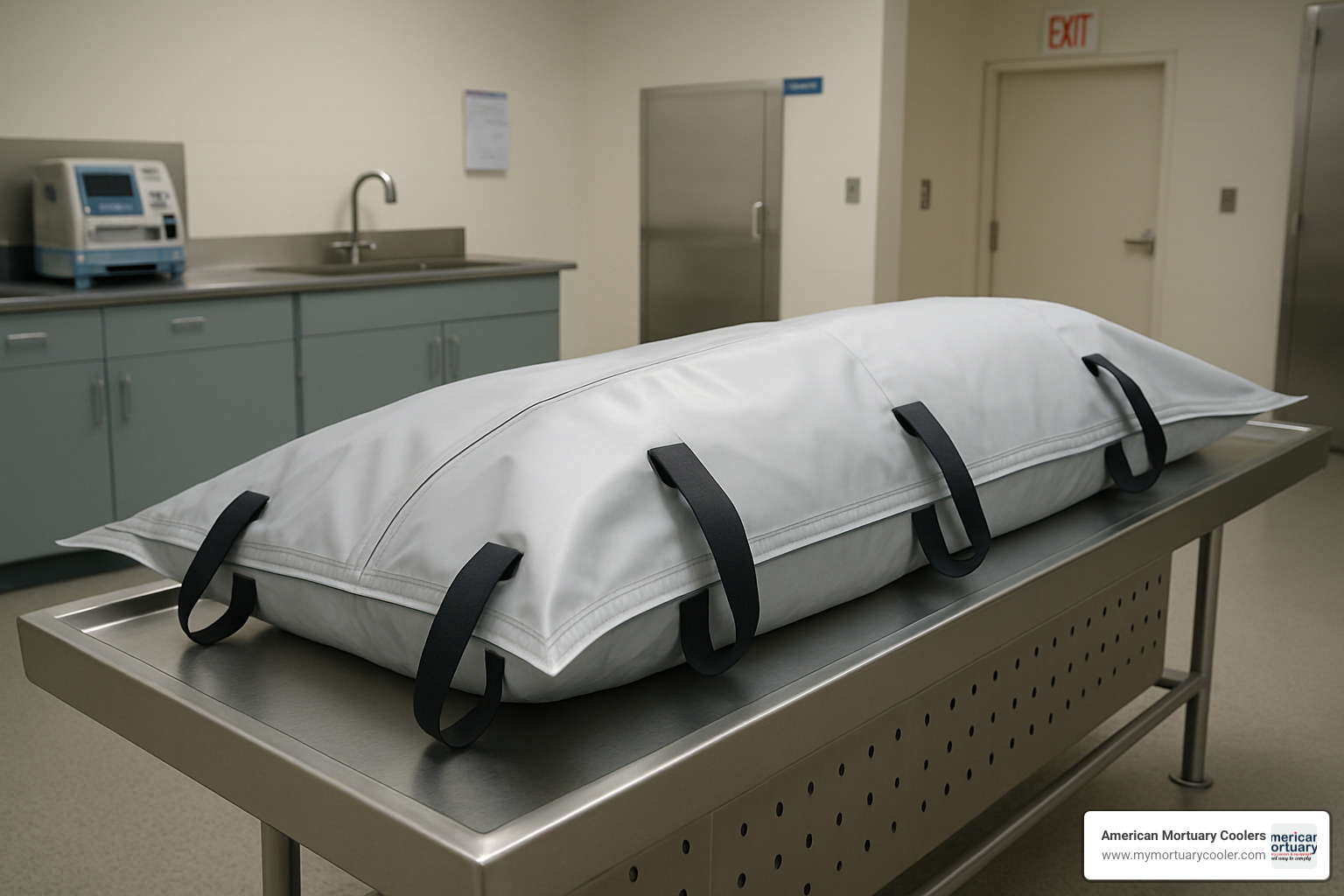
On a lighter note, it's interesting to see how the term "body bag" has entered broader cultural contexts, including its adoption in fashion for a type of cross-body sling bag. This linguistic evolution shows how technical terminology can find new life in unexpected places – though I doubt many fashion enthusiasts know the origin of their trendy accessory's name!
At American Mortuary Coolers, we're committed to staying at the forefront of these innovations, ensuring our funeral home partners across the country have access to the most advanced, environmentally responsible containment solutions available.
Frequently Asked Questions about Body Bag Body
Are body bags reusable?
No, body bag body containment systems are strictly single-use items. I've often been asked this question by new funeral directors looking to manage costs, but the answer is always the same - reusing body bags would create serious health hazards and compromise both dignity and safety.
Think of body bags like surgical gloves or other medical protective equipment. Once they've contained human remains, they're considered biohazardous material. After use, they're typically incinerated alongside other medical waste, ensuring any potential pathogens are completely destroyed.
Beyond the hygiene concerns, reusing bags would also compromise chain of custody in forensic cases and potentially transfer trace evidence between cases - something no funeral home or medical examiner wants to risk.
How do I choose the right mil thickness?
Selecting the right thickness for your body bag body needs doesn't have to be complicated. Think of mil thickness as similar to choosing the right weight of trash bag for different household tasks - except this choice carries much more significance.
For everyday removals and transfers at your funeral home, standard 6-8 mil bags generally provide sufficient protection. These work well for routine cases where the risk of tears is minimal. When I talk with funeral directors in smaller communities, this is often their go-to choice for most situations.
Medium-duty options (10-12 mil) become valuable when you're handling cases that might need a bit more durability or longer storage time. The extra thickness provides peace of mind against minor punctures.
For challenging situations - perhaps a bariatric case or a removal from difficult terrain - heavy-duty 15-18 mil bags offer superior protection. The additional material significantly reduces the risk of tears during transport and provides improved fluid containment.
In disaster response scenarios, the thickest options (20+ mil) become essential. These robust bags can withstand extreme handling conditions when resources are stretched thin and every bag must perform flawlessly.
At American Mortuary Coolers, we typically suggest keeping a varied inventory - perhaps 70% standard bags, 20% medium-duty, and 10% heavy-duty options. This balance tends to cover most situations while keeping costs manageable.
Can a heat-sealed body bag be cremated?
The cremation compatibility of heat-sealed body bag body systems depends entirely on what they're made from. This is an important consideration that many funeral directors overlook until they're faced with the question in the moment.
Traditional PVC heat-sealed bags aren't recommended for cremation. When burned, PVC can release chlorinated compounds that may damage crematory equipment and potentially create environmental concerns. I've heard from crematory operators who have had to halt operations to address issues caused by improper materials.
PEVA (Polyethylene Vinyl Acetate) heat-sealed bags offer a better alternative for cremation. Being chlorine-free, they produce fewer problematic emissions during the cremation process. These have become increasingly popular as more funeral homes seek environmentally conscious options.
Some specialized systems like BodySealer incorporate metal foil barriers that the manufacturers advertise as cremation-compatible. However, I always recommend verifying this with both the bag supplier and your crematory equipment manufacturer before proceeding.
The safest approach is to specifically request bags labeled as "cremation-safe" when ordering. At American Mortuary Coolers, we can help you identify which options in our inventory meet this requirement, ensuring you're prepared for any family's wishes regarding final disposition.
Conclusion
The evolution of body bag body containment systems represents a remarkable journey in mortuary science. What began as simple coverings has transformed into sophisticated tools that balance practical needs with dignity, safety, and increasingly, environmental responsibility.
From basic vinyl pouches to advanced hermetically sealed systems, these essential tools continue to adapt to our changing world. The modern funeral professional now has access to options that previous generations could hardly imagine – from eco-friendly materials to high-tech sealing systems.
As you consider what's right for your facility, we recommend taking a thoughtful, future-proof approach to your procurement strategy:
First, maintain a diverse inventory with various sizes and thicknesses. The reality is that no single body bag works for every situation, and being prepared means having options ready when you need them most.
Second, consider incorporating environmentally friendly options, particularly for cremation cases. The funeral industry is increasingly embracing sustainable practices, and your body bag choices can be part of that positive change.
Third, ensure your protocols align with all applicable regulations. Standards continue to evolve, and staying compliant isn't just about avoiding problems – it's about providing the best possible care.
Finally, regularly review and update your handling procedures. Best practices change, and the most successful funeral professionals are those who grow with the industry.
At American Mortuary Coolers, we understand that effective body containment works hand-in-hand with proper refrigeration. Our custom mortuary coolers and refrigeration solutions complement appropriate body bags to create a complete system for dignified, safe, and efficient care of the deceased.
With locations across the United States including Johnson City TN, Atlanta GA, Chicago IL, and Los Angeles, we're your neighbors – not just another vendor. Our direct delivery across the contiguous 48 states ensures that funeral homes nationwide have access to quality mortuary equipment, including refrigeration systems that work seamlessly with your body bag inventory.
For more information about our custom solutions and how they integrate with modern body containment systems, explore our American mortuary cooler & body-bag expertise.
The right body bag body containment system, paired with appropriate refrigeration, forms the foundation of professional, respectful mortuary operations. It's a standard we remain committed to upholding in every community we serve. After all, in this profession, the details matter – because every person in your care deserves nothing less than excellence.
















